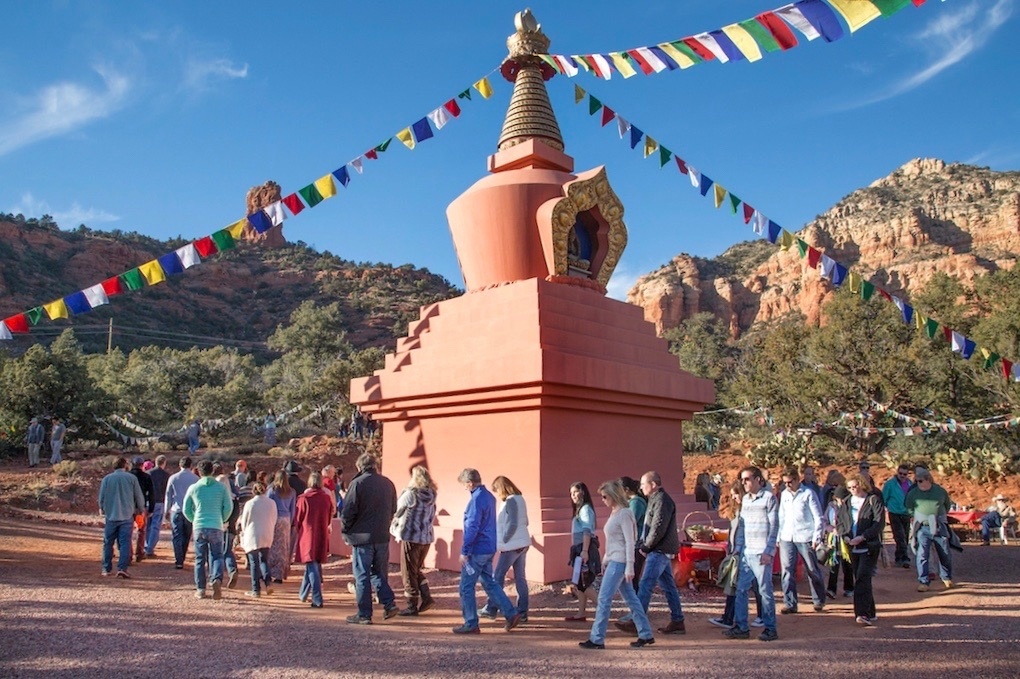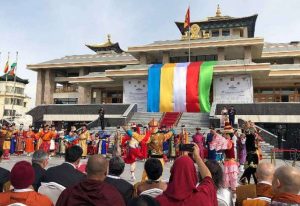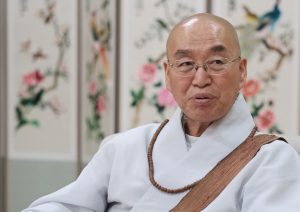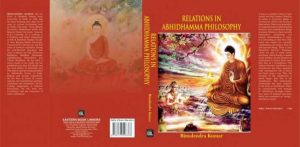
Kunzang Palyul Odsal Changchub Choling (usually shortened to Kunzang Palyul Choling or KPC), a Tibetan Buddhist center in the United States, has created two stupa peace parks—one near Washington, DC, the other in Sedona, Arizona—to provide places of pilgrimage where people of all spiritual traditions can visit, pray, and meditate to find peace and benefit for themselves and others.
“Here in the United States there are so few place to expect the miraculous—places to visit and really know that great benefit will come,” lamented Jetsunma Ahkon Lhamo many years ago. Jetsunma, the spiritual director of Kunzang Palyul Choling, decided to remedy the situation by creating pilgrimage sites or peace parks around traditional sacred Buddhist monuments called stupas. For centuries, stupas, which symbolize and embody the enlightened mind, have been spiritual destinations throughout Asia, revered for the blessings they bring to individuals, the surrounding community, and the land. In the West they are still rare treasures.
Stupas anchor enlightened energy wherever they are built, offering protection from disasters, such as war, disease, famine, poverty, and environmental upheavals, while fostering peace, harmony, and well-being. On the most profound level, stupas catalyze spiritual transformation. It is this limitless capacity to benefit beings that inspires Jetsunma to build stupas.
Beginning in the mid-1980s, under the supervision of accomplished stupa masters in the Tibetan Buddhist tradition, Jetsunma’s students began to build stupas in beautiful settings so that people of all spiritual traditions could visit to pray and meditate, make wishing prayers for themselves, their loved ones, and the world, and be comforted and inspired. KPC has created two stupa parks that are open to the public every day from sunrise to sunset: the Migyur Dorje Stupa and Peace Park at KPC’s headquarters in Poolesville, Maryland, and the Amitabha Stupa and Peace Park in Sedona. Filled with relics, prayers, and holy objects, and consecrated by qualified Buddhist masters, these stupas are like wish-fulfilling jewels sitting on consecrated land, their blessings extending for many miles.

The Migyur Dorje Stupa and Peace Park: Across River Road from the KPC Temple in Poolesville, where a 24-hour vigil for peace has continued unbroken since April 1985, walking trails crisscross 65 protected and wildlife-friendly acres (26 hectares). These trails lead to meditation gardens and magnificent stupas.
Perhaps the crowning jewel of the stupas in Maryland is the 38-foot (11.6-meter) Migyur Dorje Stupa, which is dedicated to the elimination of physical and mental illnesses, especially those that are chronic and difficult to cure. Golden in color, it is ornately decorated with traditional Tibetan Buddhist symbols, such as snow lions and offering bowls. This stupa enshrines a rare and precious bone relic of the great 17th-century Tibetan Buddhist master Migyur Dorje. Asian stupas enshrining Migyur Dorje’s relics have long been revered as sites of miraculous healing. In Maryland, too, many visitors have reported reversals of chronic and life-threatening illnesses.
In the northwest section of the Peace Park there is a remarkable clustering of stupas. This area consists of nine stupas: an 18-foot (5.5-meter) enlightenment stupa in the center, and eight smaller stupas circling on the periphery. Each of the eight stupas is slightly different and symbolic of a significant event in the life of the historical Buddha who lived in India some 2,500 years ago. Together, they represent all the stages of enlightenment and help to awaken one’s spiritual potential. “The energy here is amazing,” wrote one visitor. “It can bring a small bit of peace to anyone.”
Five other small stupas are sheltered in wooden shrines in five meditation gardens located at the four compass points of the Peace Park and at the center. More stupas stand next to the temple on the opposite side of the street, including a glistening white 36-foot (11-meter) enlightenment stupa, surrounded by woods, flowers, and offerings.
Although the Migyur Dorje Stupa and Peace Park is in a quiet country setting, its proximity to the nation’s capital (just 33 miles (53km) away) gives it special meaning. “I was hoping the stupas would positively influence our government,” Jetsunma has said.

The Amitabha Stupa and Peace Park: In Sedona, a town renowned worldwide as a spiritual destination because of its sacredness to the Native American peoples, its potent energies, and its metaphysical practitioners, the Amitabha Stupa and Peace Park stands out as a must-see stop for thousands of travelers each year. The 14-acre (5.7 hectare) park is on Pueblo Road, to the left of Andante Drive.
On any given day, dozens of visitors hike up the short winding trails to the 36-foot (11-meter) red Amitabha Stupa and the smaller Tara Stupa that stands nearby to enjoy the peaceful setting and to offer prayers and good wishes for themselves, loved ones, and the world. Others visit the large wooden Buddha that overlooks the stupas.
The site, which is also a wildlife refuge, has an unusually auspicious configuration, according to both Buddhist cosmology and Feng Shui principles. This configuration gives the land a palpable potency that many visitors have noticed. Writing in a guest book that sits nearby, people from all over the world have remarked on how moved they were by their visit. “Being near a stupa is like finding an oasis of peace,” one person said.
“I can’t think of anything that is a more worthy goal than to offer stupas to sentient beings,” says Jetsunma. “Building a stupa is like giving birth to a Buddha and offering it to the world.”

Sylvia Somerville is a freelance writer and editor living in Sedona, Arizona. She has written many articles about stupas for both print and online publications.
See more






